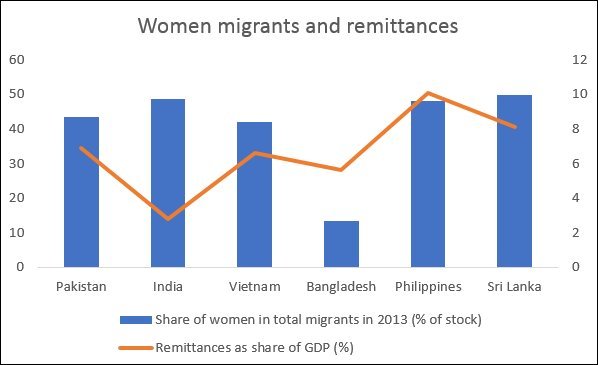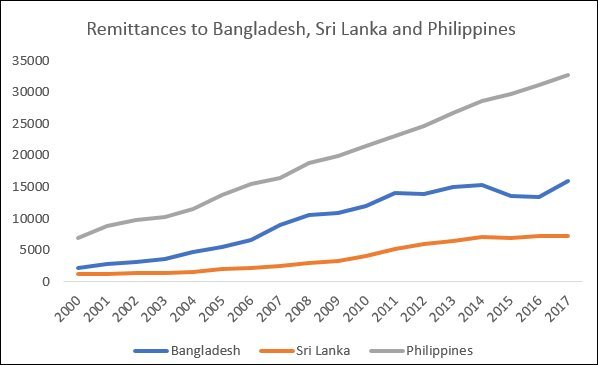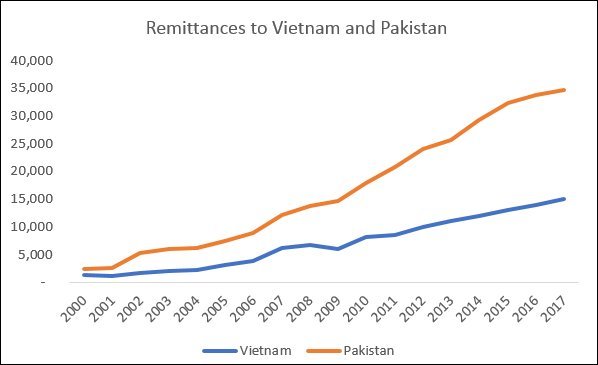From C. P. Chandrasekhar and Jayati Ghosh The gender distribution of migrant workers has a macroeconomic impact – it affects both the level and the volatility of remittance inflows, as the Asian experience shows. The gender distribution of cross-border migration obviously matters because women migrating for work face very different conditions from those of men migrants, whether in the source country, or in the process of travel or in the destination country. These are crucially affected by the gender construction as well as the nature of labour markets in both societies of origin and destination. This is well accepted and now quite widely studied. However, the macroeconomic impact of such gendered migration has remained much less apparent and less analysed. Specifically, the impact of
Topics:
Editor considers the following as important: Uncategorized
This could be interesting, too:
tom writes The Ukraine war and Europe’s deepening march of folly
Stavros Mavroudeas writes CfP of Marxist Macroeconomic Modelling workgroup – 18th WAPE Forum, Istanbul August 6-8, 2025
Lars Pålsson Syll writes The pretence-of-knowledge syndrome
Dean Baker writes Crypto and Donald Trump’s strategic baseball card reserve
from C. P. Chandrasekhar and Jayati Ghosh
The gender distribution of migrant workers has a macroeconomic impact – it affects both the level and the volatility of remittance inflows, as the Asian experience shows.
The gender distribution of cross-border migration obviously matters because women migrating for work face very different conditions from those of men migrants, whether in the source country, or in the process of travel or in the destination country. These are crucially affected by the gender construction as well as the nature of labour markets in both societies of origin and destination.
This is well accepted and now quite widely studied. However, the macroeconomic impact of such gendered migration has remained much less apparent and less analysed. Specifically, the impact of gendered migration on the sending of remittances is an issue that is often ignored, even though it can be very significant.
This is not only because women migrating for work have been known to send a greater proportion of their earnings back as remittances and to send more regularly than men. It is also because typically, the nature of the work differs. Men migrant workers are mostly to be found in manufacturing and construction activities in the host countries, and to a much lesser extent in services. Women migrants, by contrast, are overwhelmingly in service work, particularly in care activities, and to a much small degree in hospitality and entertainment sectors.
This has direct implications for earnings and therefore for the ability (apart from the willingness) to send remittances back to migrants’ homes. Male migrant workers are much more immediately affected by business cycles in the host economies, tending to lose jobs or experience reduced incomes, which thereby affects the remittances they can send. Women working in services activities, by contrast, especially those in care services such as nurses or domestic workers, are less likely to be immediately affected by the business cycle as these activities are not the first to be curtailed. Therefore, their incomes and ability to send remittances are less affected.
This means that countries that send more women migrant workers out are likely to show a more stable pattern of remittance inflow than countries with dominantly male out-migrants. This is clearly evident in migration out of Asian countries.
Figure 1 suggests that women have been significant in cross-border migration in several Asian countries – although these data (from the International Organisation on Migration) refer only to the stock of permanent recorded migrants and do not capture short term movements for work. Sri Lanka, the Philippines and India showed high ratios of female migrants, followed by Pakistan and Vietnam – but Bangladesh showed a very low ratio. In all these countries, remittances formed a significant proportion of GDP.
Figure 1

The most interesting contrast in remittance inflows is between Sri Lanka and the Philippines, on one hand, and Bangladesh on the other. From the late 1980s until the mid 2000s, women accounted for most of the labour migration from Sri Lanka, dominantly as domestic workers. In the mid 1990s they accounted for 75 per cent of the migrant outflow, which declined thereafter to less than half by the late 2000s. The remittance inflows show a pattern of smooth increase, tapering off after 2010.
Figure 2

Between 1980 and 2013, women dominated out-migration from the Philippines, accounting for 60 per cent of such migrants. Their share peaked in 2004 at around three-fourths of the outflow of workers abroad, and most of them were employed as domestic workers in the destination countries. Thereafter, attempts by the Philippine government to regulate their conditions of work and reduce exploitative practices led to a reduction in the number of such women migrants, whose share shrank to less than half in 2007 and 2008. A revival thereafter led to previous levels being surpassed in 2010. Correspondingly, remittance inflows also increase continuously, despite some slowdown in the late 2000s.
By contrast, Bangladesh has had very strict laws on women’s external mobility (which require the permission of the male head of household) and has restricted women’s migration. Remittance inflows have been much more volatile and have even fallen in several years, as the predominantly male migrant workers have been affected by fluctuating economic conditions in the major host countries (the Middle East and US).
Figure 3

For Pakistan, less of the female migration has been for work and more for reasons of marriage – and this has affected the volatility of remittances as well, as Figure 3 indicates. In Vietnam, the growing significance of women migrants has been reflected in a smoother trend increase in recent years compared to the past.
The Indian case presents a more complex picture. Women workers have been around half of the recorded migrants, yet remittances display a more volatile pattern. This relates to the specific nature of the origin of remittances, which is in turn determined by the destination of migrants as well as by gender. In 2013, 52 per cent of the stock of Indian migrants abroad were in just two countries in the Middle East: Saudi Arabia and United Arab Emirates. Just under a quarter were in the United States.
This excludes the Indians living in the US on temporary visas like H1B visas, who are more likely to send remittances than permanent migrants; indeed, remittances from the US have accounted for around half of total remittances over the past decade. But such remittance flows emanating from temporary but high-skilled workers tend to be larger than the smaller amounts sent by women workers in less skilled care activities in the Middle East. Therefore, while the women migrants mostly continue to send remittances in periods of downswing, male professional workers on short-term visas are more directly affected by adverse economic conditions.
Figure 4

So in this matter (and in so much else in the matter of employment patterns) the Indian experience tends to be somewhat of an outlier with regard to the relationship between gendered migration and remittances.
(This article was originally published in the Business Line on February 26, 2019.)
